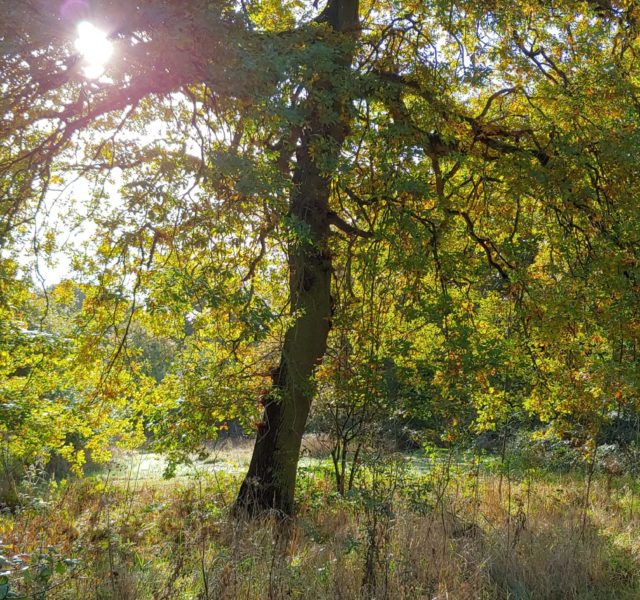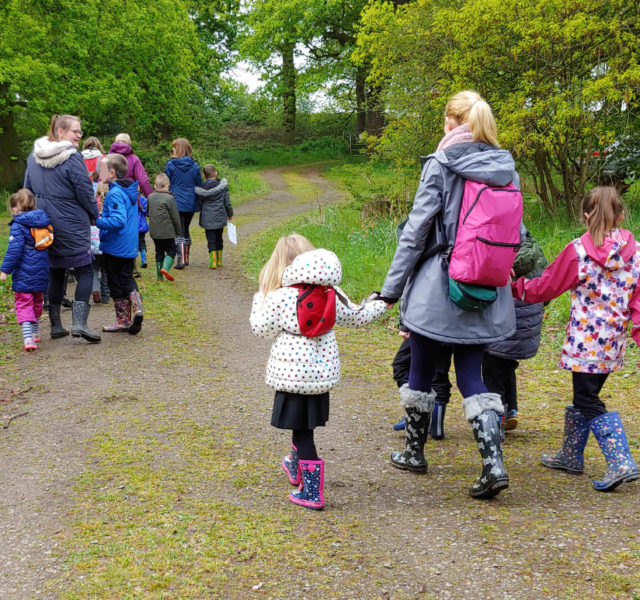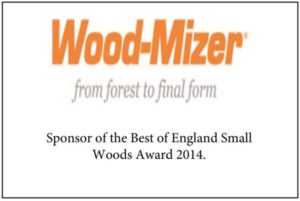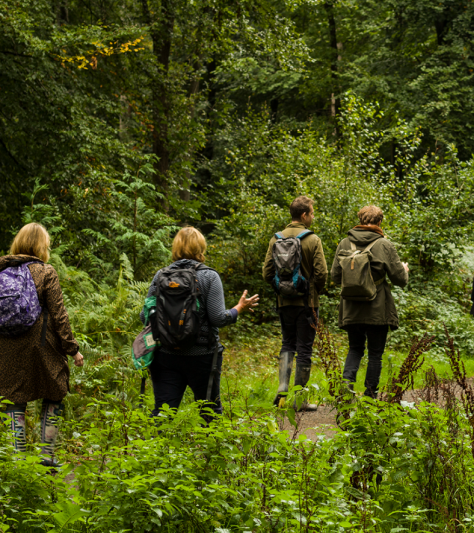Alvecote Wood – Our story
Winning the Gold Best of England Award and the regional Small Woodlands Excellence in Forestry Award in 2014, Sarah Walters describes how forestry novices went about turning a neglected site into award-winning conservation woodland.




From novices to winners
In 2013 Alvecote Wood won the RFS Excellence in Forestry award in the small woodlands category. This represented a major journey in just six years from neglected woodland with novice owners to an award-winning site.
We do not have a forestry background, although both of us have had a lifelong interest in conservation and wildlife. Stephen is an engineer and Sarah a doctor who took ill health retirement in 2006 due to the inherited disease cystic fibrosis. We frequently passed Alvecote Wood, just a mile from our home, on our regular cycling route, and in 2007 Stephen noticed a ‘For Sale’ sign in the ditch. We were drawn to the neglected site for its wildlife potential, and Sarah’s pension lump sum gave us the wherewithal to compete in the sealedbid auction. The previous owners were impressed that we
wanted to do what they had been unable to do with the site, and after some last minute haggling, we became owners on 2 October 2007.
We knew that the 4.45ha (11 acre) wood was ancient semi natural woodland from its designation, and research into its history confirmed this to be the case, its unusual shape dating back at least to 1650 and almost certainly earlier, with woodland on the site before Domesday. Its characteristics
were not that of typical ASNW, having been heavily modified by its use as wood pasture through the 19th and 20th centuries, with grazing by sheep, pigs, cows, horses and goats. It was overgrown with effusive brambles, nettles and elder thanks to its high fertility. The majority of trees were pedunculate oak aged between 100 and 200 years, with almost no trees aged between these and saplings grown in the last few years since grazing ceased. Regeneration was not happening thanks to the stifling bramble overgrowth. The site was also becoming waterlogged thanks to failure of drainage, with trees dying and falling as a result. Access into the site was poor and on a dangerous blind bend, and access around the site was limited by bramble and successive generations of stock fencing in various degrees of decay. There was a lot of work to be done to realise our dream of managing it for wildlife and use by community groups.
Seeking Advice
The first thing we did was to seek advice from anybody and everybody we felt could help. The local Forestry Commission (FC) officer (Paul Webster) was of enormous help, as were the Warwickshire Wildlife Trust, the eminent local naturalist Maurice Arnold, the local Parish Council, Pond Conservation, Butterfly Conservation and many others too numerous to mention. We were encouraged to put in place a management plan, and to apply for various grants from the FC to help with fencing, improved access tracks and general woodland management. We also applied for a felling licence, and for permission to construct a shed for equipment including a tractor – permission that was granted owing to the presence
on site of concrete foundations for early 20th century livestock housing. We were advised that we needed a tractor, and were lucky to find a 40-year old tractor in good condition at a local farm auction that could be put to work with relatively little renovation, as well as a rotary slasher at a reasonable price.
Initial work
In the first couple of years we set to building a new, safer entrance, category 1 and 2 forestry tracks, equipment shed, six new ponds, and bridges across ditches. We also renovated the drainage on site, repaired and replaced boundary fences and removed internal partitions, many of which were hidden under profuse bramble growth. We cut new mown paths and rides, created an area for occasional camping, and planted new wildflower areas in the main clearing. We also planted a new hedge along the roadside and undertook tree safety work along the road and within, so that we could start a programme of public open days on a site that was previously closed to the public. Saplings that were struggling to escape the brambles were cut free and protected. In 2009-10 we started to restore an over-stood coppice on the site, as well as planting areas we had cleared of bramble with future coppice of ash, hazel and field maple. We also started to thin an area that had been protected from grazing and was now over-dense, with straggly trees, little light, and a few European larch trees out of character for the site. Upon advice, we also removed the single mature sycamore that was generating a lot of seedlings capable of overwhelming the ancient oak woodland. Work continues every year to expand the coppice, clear the rather rampant large holly population, and encourage regeneration in areas where the canopy is broken.
Expansion – Betty’s Wood
In 2010 the neighbouring farmer approached us to see if we would like to purchase part of the adjacent arable field. This was marginal land, damp and waterlogged with evidently poor yield, but valuable from a wildlife perspective, linking our woods with another small remnant of ancient woodland, an ancient hedgerow, and across the canal with a SSSI. We were already busy, but by chance had money to buy this land after Sarah’s mother passed away, and so 3.6ha (9 acre) Betty’s Wood was born, taking the site up to just over 8ha (20 acres) in size. In 2010-11 we created a new wildlife woodland with a Woodland Creation Grant from the FC. This was carefully planned to incorporate a linking native hedgerow, wildflower meadows, a natural regeneration area, five new wildlife ponds, areas of mixed native broadleaf woodland and wet woodland to be managed in different ways (coppice, continuous cover forest and wet carr). All species planted there were either growing already in the woods, or on sites nearby – oak, ash, hazel, rowan, cherry, white willow, goat willow, field maple, lime, silver birch, aspen, poplar, sweet chestnut, crab apple, hawthorn, holly, alder, alder buckthorn and in the hedge, guelder rose, spindle, and dog rose, with some emergent oaks. We sought to create as diverse a set of habitats as possible, and in total about 6500 trees have been planted, cloned or regenerated on this site, and it is already flourishing with diverse wildlife. The Director of Pond Conservation came along to help us develop our ponds, pacing out their dimensions and depths while we had a digger on site, so they could be as good as possible, and we have been richly rewarded.
Wildlife
Our love for wildlife was the prime motivator for and remains at the heart of this project. The site was already very promising, but it has grown better and better with every passing year. We have a good range of red-listed and amberlisted birds, including yellowhammer, willow tit, lesser spotted woodpecker, barn owl, lapwing, skylark, linnet, spotted flycatcher, cuckoo, woodcock, jack snipe, kestrel, buzzard, hobby, sparrow hawk and reed bunting. We have already attracted the two target species of butterfly to our site through management of wildflower meadows (brown argus and dingy skipper) and greatly increased presence of common blue, small, large and Essex skippers, small heath, small copper, brimstone and other meadow butterflies, as well as having a notable population of woodland butterflies, particularly purple hairstreak. There are promising signs of regeneration of food plants in our coppice, including violet and honeysuckle. Butterfly Conservation Warwickshire has undertaken moth
monitoring on the site, with excellent results including a firstever sighting for Warwickshire. Dragonflies and damselflies are also thriving in our eleven ponds.
When we took ownership we already had some interesting wildflowers including snakeshead fritillary, cowslip primrose and blue bugle. Bluebells carpet the woodland floor in spring. The wildflower variety and range has since expanded, and we also have a fantastic patch of southern marsh orchid in Betty’s Wood.
In the last couple of years we have seen grass snakes in two locations, as well as common frog, common toad and smooth newt. As well as the common mammals on site (rat, field vole, bank vole, wood mouse, grey squirrel, fox, rabbit, badger), we also have stoats. Muntjac deer are less welcome and mean we have to protect all planting and coppice stools very carefully, using recycled stock netting and chicken wire to exclude the rabbits. We have identified common and soprano pipistrelles and noctule bats in the woods.
We are actively involved in survey and recording programmes for birds, butterflies, moths, dragonflies and wildflowers. The woods are now a Local Wildlife Site and Site of Importance for Nature Conservation and we work closely with Warwickshire Wildlife Trust to ensure they are managed to
maximum potential. Every year the range of wildlife increases; only this morning, I heard raven calling, and saw a flock of long-tailed tits using our new hedgerow to pass from one piece of woodland to another. Lapwing have already found our new ponds, and linnet, goldfinch and siskin feed on the teasel growing on their banks, and bullfinch have found our coppice. We had an exciting sighting of a white admiral butterfly last summer. The site is alive and improving every year.
Public Engagement
We were keen right from the start to engage the local community and offer them the opportunity to visit and enjoy the woods and the wildlife. However we were also keen to preserve the undisturbed character of the woodland and the sanctuary offered to wildlife away from people, paths and dogs. We struck a balance by starting a programme of monthly open days running from March to November each year, with guided tours, woodcraft demonstrations and a craft stall. We have also started opening the woods once a week for two hours on Wednesday evenings in the summer months. Community groups are also welcome to the woods, and we have had multiple visits from and camping by the Scouts, as well as visits and tours for local wildlife, birdwatching, natural history and other groups. Schools are also welcome, although access is an issue, as are the lack of toilet facilities, and we have undertaken our CEVAS (The Countryside Educational Visits Accreditation Scheme) training.
Sarah studied a professional photography course and held her final exhibition for it in the woods, and now runs photography workshops in them. We have also welcomed other activities including wedding and fashion photo-shoots.
There is a fantastic group of volunteers who helped us plant Betty’s Wood, as well as helping with coppicing and general woodland maintenance during the winter. We have also welcomed people from the Starfish project (which helps people with mental health, drug and alcohol problems) to a work party in Betty’s Wood. Haymaking also needs volunteers, and their help generated a good crop of hay for local horse owners in 2013.
Both of us have experience of website design, which helped develop our active website, and we also make use of social media including a blog, Facebook and Twitter. The latter have proved very successful in helping to engage the local community and supporters, and Twitter proved the best way of engaging new volunteers. Upon invitation, we are also very willing to give talks to wildlife and other community groups, and usually give about five or six talks a year. We are always willing to welcome people to the site by appointment. This year we hope to develop a guided walk using QR codes that visitors with smartphones can use to access information at various points round the woods.
Products
Our priority is the wildlife, but that doesn’t mean that wood and hay arising from management for wildlife cannot be used! Initially, we were constrained by lack of space for seasoning firewood, and were only able to supply ourselves, but in late 2012 we completed a new wood-drying shed, and we have permission to extend this. As a result we can now offer bags of seasoned firewood for sale at our open days. We also keep better quality wood for production of slabs for use as table tops and benches, although this has to wait until we have enough to hire a mobile sawmill for the day.
Sarah also enjoys green woodturning, making small items such as garden dibbers, rolling pins, tool handles, chair legs, cord pulls and mushrooms. We both do a bit of chainsaw carving, making simple stools and toadstools. We have plans to make rustic furniture and walking sticks, and when our coppice is cut again, and when Betty’s Wood comes online, there is the potential for beanpoles, stakes, pea sticks and other coppice products. In 2013 we generated 140 bales of dry wildflower seed hay for local stables. Production of craft products, seed hay and firewood are likely to expand in future as Betty’s Wood grows, and our coppice becomes more productive.
Future plans and landscape-scale conservation
Our site sits in the valley of the River Anker adjacent to the Coventry Canal, across which there is a SSSI. There are several other wildlife sites in the area, as well as areas being managed by farmers under stewardship for wildlife. There are also initiatives to develop other wildlife areas with public access along the canal and in the villages and towns by various landowners including the local councils. We could see the potential for this area to become a landscape-scale conservation area, provided the efforts were coordinated, and ultimately this could draw in more funding. In 2011 we instigated the Anker Valley Project and have already held multiple meetings with various stakeholders including Warwickshire and Staffordshire Wildlife Trusts, Canal and River Trust, Environment Agency, Forestry Commission, Natural England, Butterfly Conservation, North Warwickshire Borough Council and local wildlife enthusiasts. We hope to set up a landowner meeting to take forward some demonstration sites that have been identified. The Anker Valley Project will hopefully deliver benefits for wildlife and people into the future, and link with other landscape-scale projects such as the Tame Valley Partnership and the Central Rivers Initiative.
Advice for the novice woodland owner
Owning woodland is a fantastic thing – but it can be hard work and involves a steep learning curve. Our advice would be, above all, to seek and take advice from people who can help you. The Forestry Commission, Wildlife Trusts, Woodland Trust, Natural England, RSPB, Butterfly
Conservation, Pond Conservation – anybody who has the expertise that you need. Also get some training in the aspects of woodland management that you need – we have trained in coppicing, taken our chainsaw qualifications, trained in wildlife survey methods, green woodworking and
done various courses on tree diseases, woodland planning, tree safety, European Protected Species, First Aid, Wild Play coordinator, CEVAS accreditation and so on. We have also learned a lot from our volunteers, local naturalists who visit the site, and people with farming experience who have helped us learn how to use some of our equipment. Even if you are an amateur owner, you can achieve a lot more if you adopt a professional approach. It doesn’t mean you cannot just enjoy the woods – we do this a lot – but you will achieve a lot more, make a bigger difference and ultimately enjoy it more. We entered the RFS competition not because we thought we would win, but because we wanted to seek the
advice of the judges, and saw it as an opportunity to improve – and would do so again. We will keep on seeking advice, keep on learning and keep on improving – we owe it to our beautiful woods, during our short stewardship, to do so.
Sarah Walters is a retired doctor who, with her
husband Stephen Briggs, own and manage Alvecote
Wood, a small ancient oak woodland in North
Warwickshire that was recipient of the RFS Excellence
in Forestry Small Woodlands award in 2013.
Email: sarah@pragmasis.com


